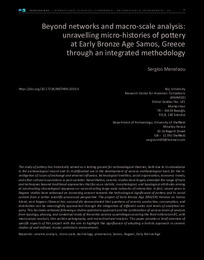Beyond networks and macro-scale analysis: unravelling micro-histories of pottery at Early Bronze Age Samos, Greece through an integrated methodology

View/
Date
2020-04-01Publisher
FF-Open Press, University of ZagrebSource
Proceedings - International Scientific Conference - Methodology & Archaeometry 06Pages
57-69Google Scholar check
Keyword(s):
Metadata
Show full item recordAbstract
The study of pottery has historically served as a testing ground for archaeological theories, both due to its abundance in the archaeological record and its multifaceted use in the development of various methodological tools for the in-vestigation of issues of exchange and external influence, technological tradition, social organisation, economic trends, and other cultural associations in past societies. Nevertheless, ceramic studies have largely extended the range of tools and techniques beyond traditional approaches that focus on stylistic, morphological, and typological attributes aiming at constructing chronological sequences or reconstructing large-scale networks of interaction. In fact, recent years in Aegean studies have witnessed an increasing concern towards the technological significance of pottery and its social context from a rather scientific-processual perspective. The project of Early Bronze Age (EBA/EB) Heraion on Samos Island, east Aegean (Greece) has successfully demonstrated that questions of ceramic production, consumption, and distribution can be meaningfully approached through the integration of different scales and levels of analytical en-quiry. This has been achieved following a chaîne opératoire approach and the combination of various levels of analysis from typology, phasing, and contextual study of the entire ceramic assemblages covering the third millennium BC, with macroscopic analysis, thin section petrography, and microstructural analysis. This paper provides a brief overview of specific aspects of this project with the aim to highlight the significance of adopting a holistic approach in ceramic studies of well-defined, insular prehistoric environments.
Collections
Cite as
The following license files are associated with this item:

